Abstract
The relative sensitivities to ultraviolet light of various simian virus 40 (SV40) functions were studied in human and mouse cells. Transformation appeared to be less ultraviolet (UV)-sensitive than either T or V antigen when all functions were compared in the same cell. However, the time course of both T- and V-antigen appearance was delayed with UV-irradiated virus, so that the survival curves of these functions changed with time. Mouse and human cells which were transformed by UV-SV40 all contained SV40 T antigen. Infectious virus could be recovered from many more transformants than would be expected from the infectivity in African green monkey kidney cells of the irradiated virus. The results suggest that human and mouse cells are capable of reactivating UV-damaged SV40.
Full text
PDF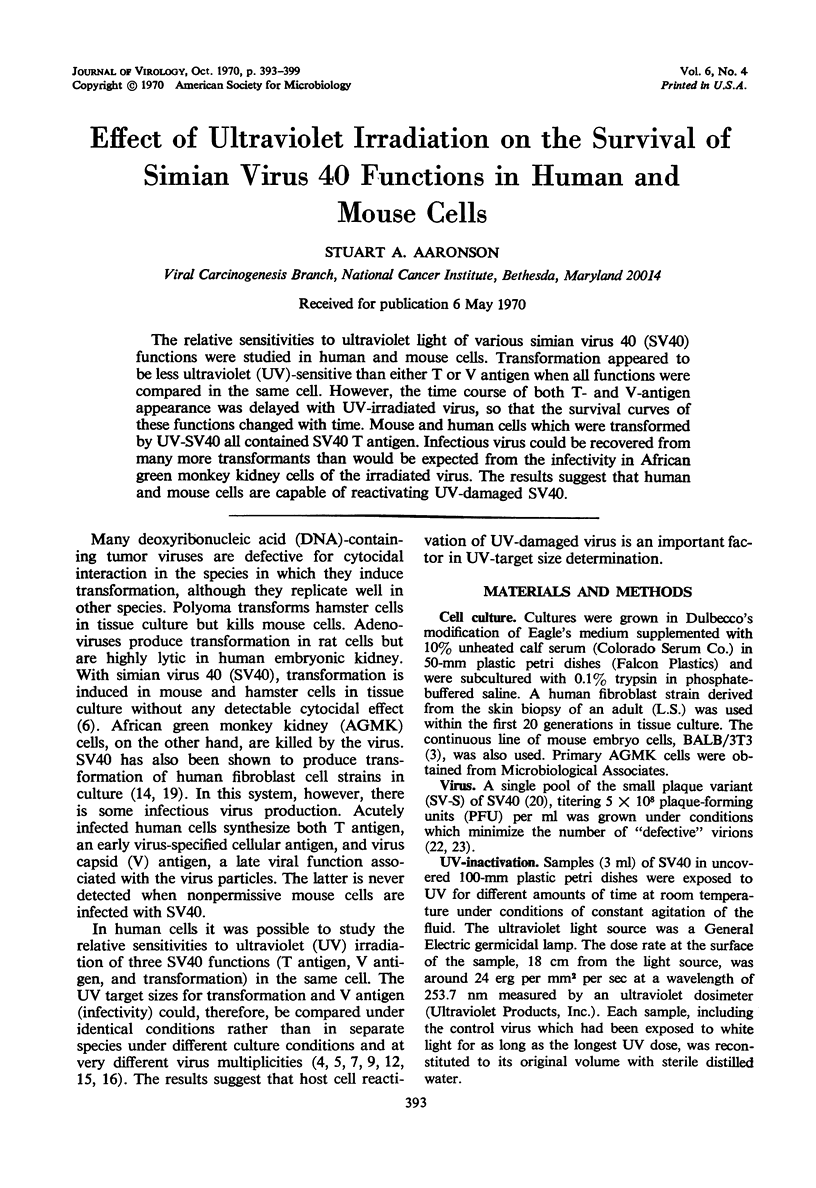
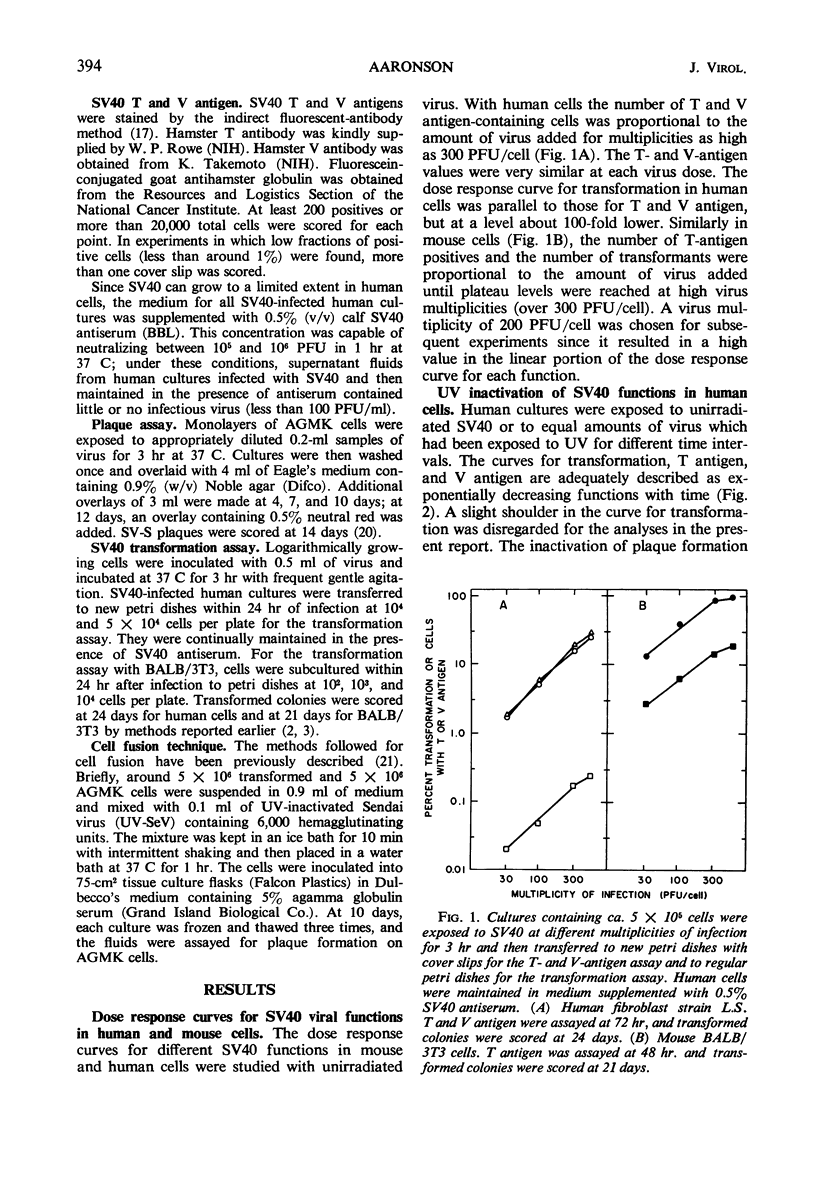
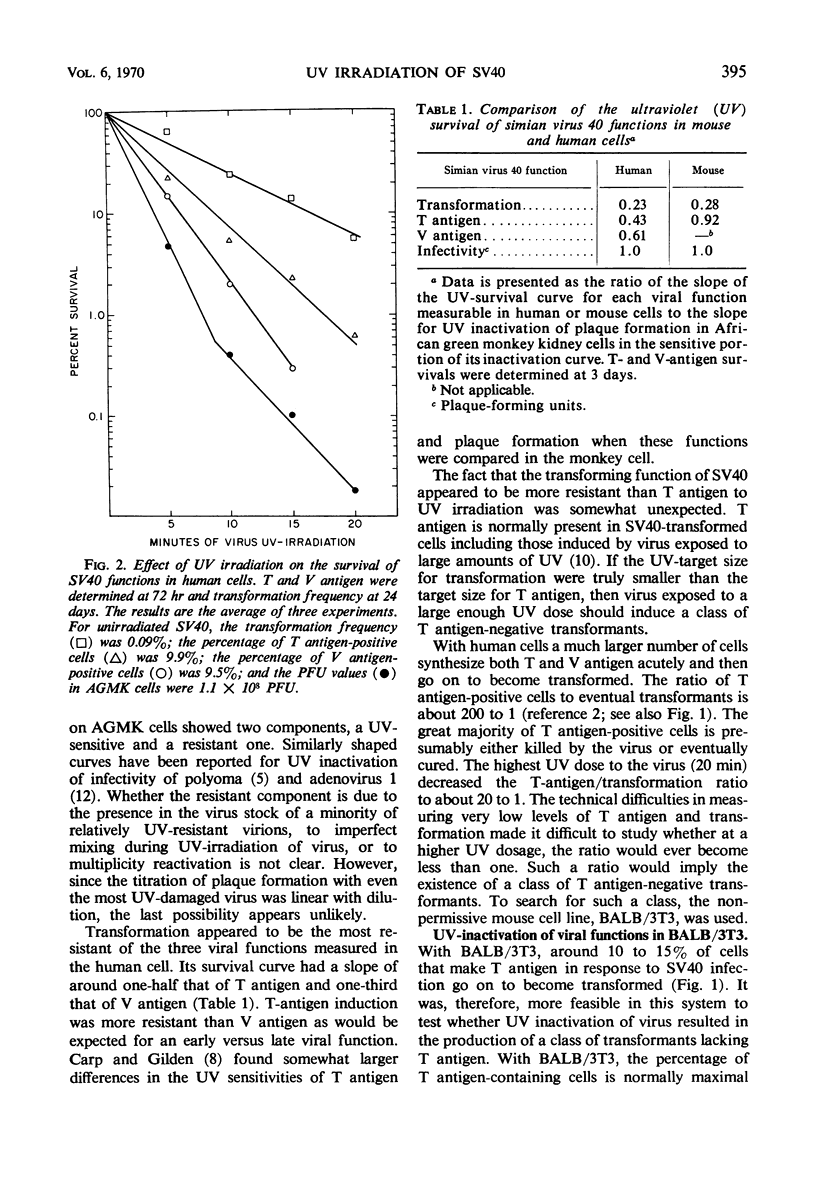
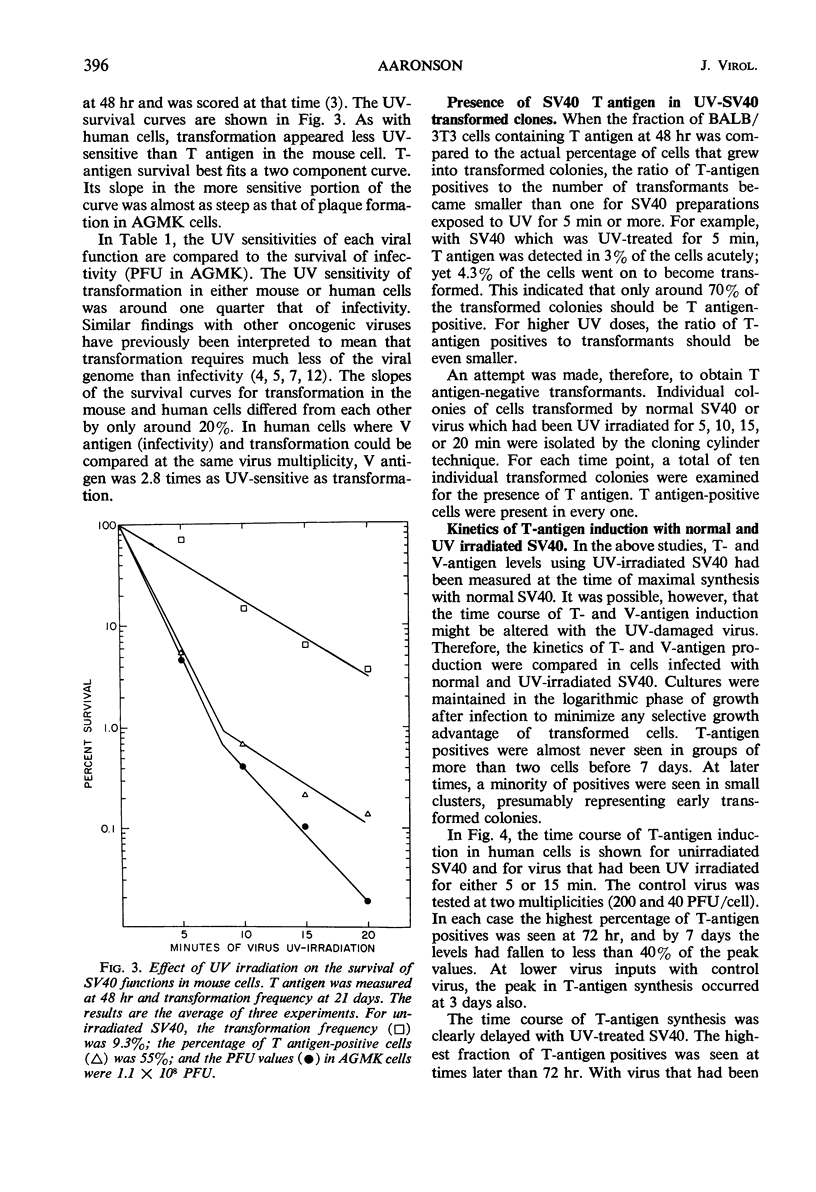
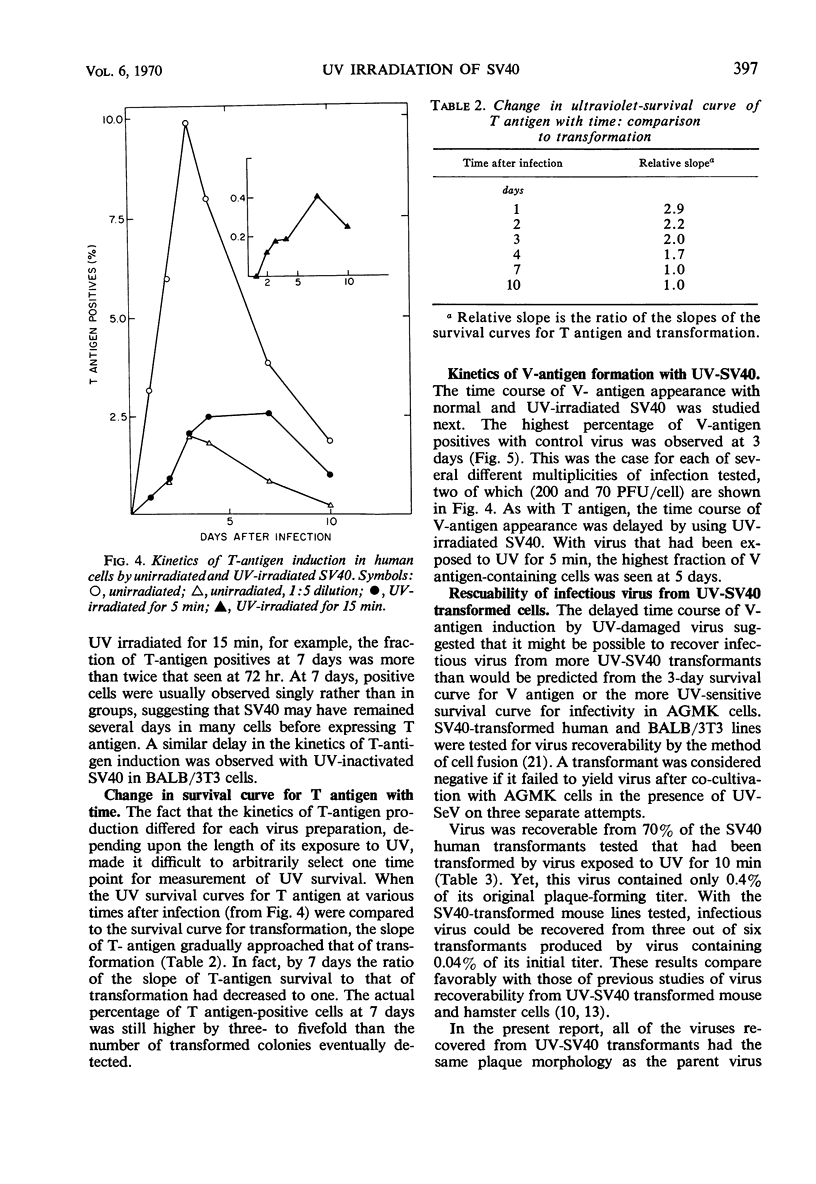
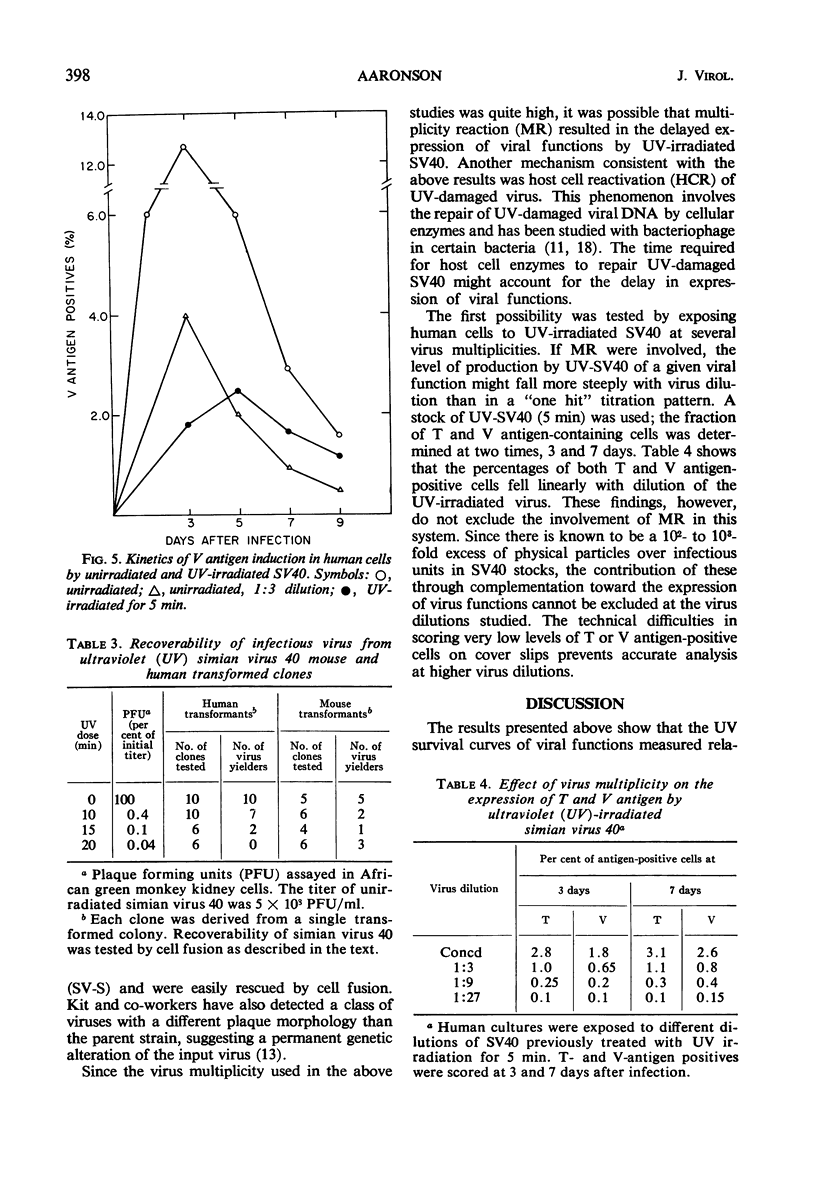
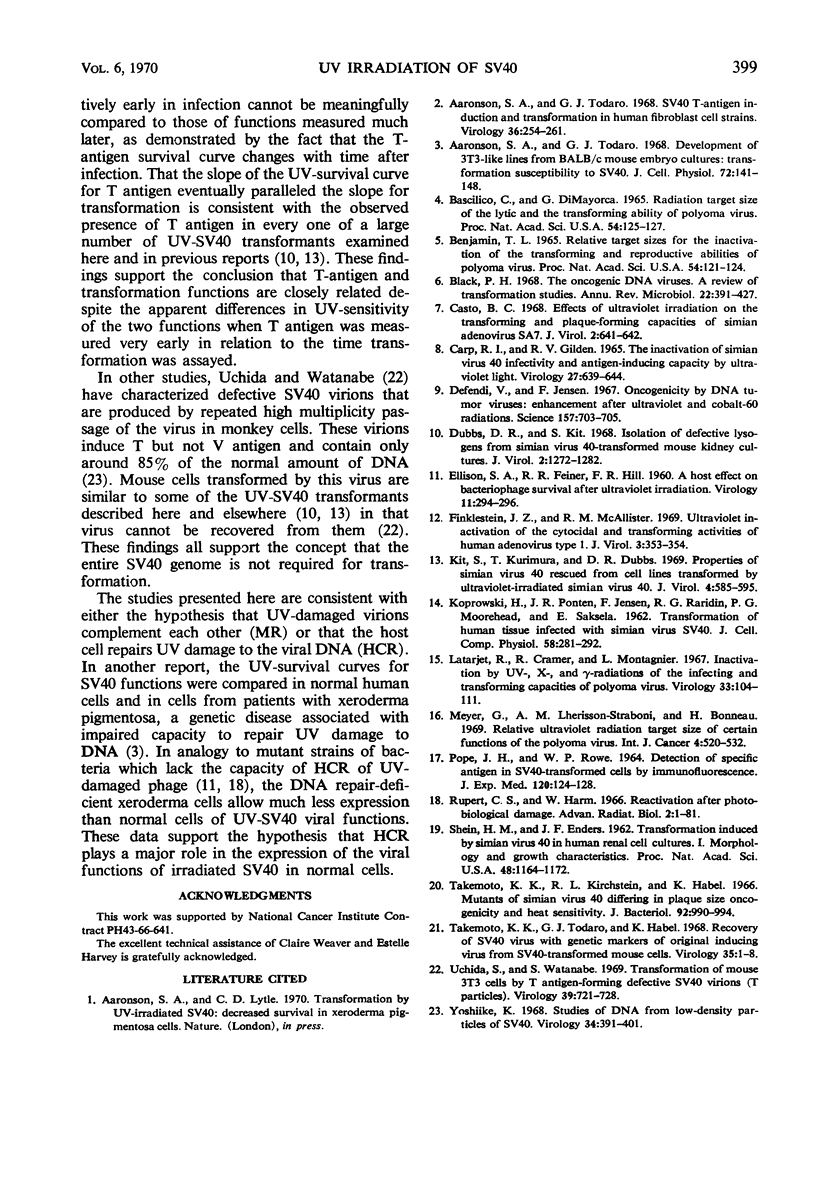
Selected References
These references are in PubMed. This may not be the complete list of references from this article.
- Aaronson S. A., Todaro G. J. Development of 3T3-like lines from Balb-c mouse embryo cultures: transformation susceptibility to SV40. J Cell Physiol. 1968 Oct;72(2):141–148. doi: 10.1002/jcp.1040720208. [DOI] [PubMed] [Google Scholar]
- Aaronson S. A., Todaro G. J. SV40 T antigen induction and transformation in human fibroblast cell strains. Virology. 1968 Oct;36(2):254–261. doi: 10.1016/0042-6822(68)90142-6. [DOI] [PubMed] [Google Scholar]
- Basilico C., Di Mayorca G. Radiation target size of the lytic and the transforming ability of polyoma virus. Proc Natl Acad Sci U S A. 1965 Jul;54(1):125–127. doi: 10.1073/pnas.54.1.125. [DOI] [PMC free article] [PubMed] [Google Scholar]
- Benjamin T. L. Relative target sizes for the inactivation of the transforming and reproductive abilities of polyoma virus. Proc Natl Acad Sci U S A. 1965 Jul;54(1):121–124. doi: 10.1073/pnas.54.1.121. [DOI] [PMC free article] [PubMed] [Google Scholar]
- Black P. H. The oncogenic DNA viruses: a review of in vitro transformation studies. Annu Rev Microbiol. 1968;22:391–426. doi: 10.1146/annurev.mi.22.100168.002135. [DOI] [PubMed] [Google Scholar]
- Carp R. I., Gilden R. V. The inactivation of simian virus 40 infectivity and antigen-inducing capacity by ultraviolet light. Virology. 1965 Dec;27(4):639–641. doi: 10.1016/0042-6822(65)90194-7. [DOI] [PubMed] [Google Scholar]
- Casto B. C. Effects of ultraviolet irradiation on the transforming and plaque-forming capacities of simian adenovirus SA7. J Virol. 1968 Jun;2(6):641–642. doi: 10.1128/jvi.2.6.641-642.1968. [DOI] [PMC free article] [PubMed] [Google Scholar]
- Defendi V., Jensen F. Oncogenicity by DNA tumor viruses: enhancement after ultraviolet and cobalt-60 radiations. Science. 1967 Aug 11;157(3789):703–705. doi: 10.1126/science.157.3789.703. [DOI] [PubMed] [Google Scholar]
- Dubbs D. R., Kit S. Isolation of defective lysogens from Simian virus 40-transformed mouse kidney cultures. J Virol. 1968 Nov;2(11):1272–1282. doi: 10.1128/jvi.2.11.1272-1282.1968. [DOI] [PMC free article] [PubMed] [Google Scholar]
- ELLISON S. A., FEINER R. R., HILL R. F. A host effect on bacteriophage survival after ultraviolet irradiation. Virology. 1960 May;11:294–296. doi: 10.1016/0042-6822(60)90069-6. [DOI] [PubMed] [Google Scholar]
- Finklestein J. Z., McAllister R. M. Ultraviolet inactivation of the cytocidal and transforming activities of human adenovirus type 1. J Virol. 1969 Mar;3(3):353–354. doi: 10.1128/jvi.3.3.353-354.1969. [DOI] [PMC free article] [PubMed] [Google Scholar]
- Kit S., Kurimura T., Dubbs D. R. Properties of simian virus 40 rescued from cell lines transformed by ultraviolet-irradiated simian virus 40. J Virol. 1969 Nov;4(5):585–595. doi: 10.1128/jvi.4.5.585-595.1969. [DOI] [PMC free article] [PubMed] [Google Scholar]
- Latarjet R., Cramer R., Montagnier L. Inactivation, by UV-, x-, and gamma-radiations, of the infecting and transforming capacities of polyoma virus. Virology. 1967 Sep;33(1):104–111. doi: 10.1016/0042-6822(67)90098-0. [DOI] [PubMed] [Google Scholar]
- Meyer G., Lhérisson-Straboni A. M., Bonneau H. Sensibilité différentielle aux rayons ultraviolets de quelques fonctions du virus Polyome. Int J Cancer. 1969 Jul 15;4(4):520–532. doi: 10.1002/ijc.2910040417. [DOI] [PubMed] [Google Scholar]
- POPE J. H., ROWE W. P. DETECTION OF SPECIFIC ANTIGEN IN SV40-TRANSFORMED CELLS BY IMMUNOFLUORESCENCE. J Exp Med. 1964 Aug 1;120:121–128. doi: 10.1084/jem.120.2.121. [DOI] [PMC free article] [PubMed] [Google Scholar]
- SHEIN H. M., ENDERS J. F. Transformation induced by simian virus 40 in human renal cell cultures. I. Morphology and growth characteristics. Proc Natl Acad Sci U S A. 1962 Jul 15;48:1164–1172. doi: 10.1073/pnas.48.7.1164. [DOI] [PMC free article] [PubMed] [Google Scholar]
- Takemoto K. K., Kirschstein R. L., Habel K. Mutants of simian virus 40 differing in plaque size, oncogenicity, and heat sensitivity. J Bacteriol. 1966 Oct;92(4):990–994. doi: 10.1128/jb.92.4.990-994.1966. [DOI] [PMC free article] [PubMed] [Google Scholar]
- Takemoto K. K., Todaro G. J., Habel K. Recovery of SV40 virus with genetic markers of original inducing virus from SV40-transformed mouse cells. Virology. 1968 May;35(1):1–8. doi: 10.1016/0042-6822(68)90299-7. [DOI] [PubMed] [Google Scholar]
- Uchida S., Watanabe S. Transformation of mouse 3T3 cells by T antigen-forming defective SV40 virions (T particles). Virology. 1969 Dec;39(4):721–728. doi: 10.1016/0042-6822(69)90009-9. [DOI] [PubMed] [Google Scholar]
- Yoshiike K. Studies on DNA from low-density particles of SV40. I. Heterogeneous defective virions produced by successive undiluted passages. Virology. 1968 Mar;34(3):391–401. doi: 10.1016/0042-6822(68)90059-7. [DOI] [PubMed] [Google Scholar]


